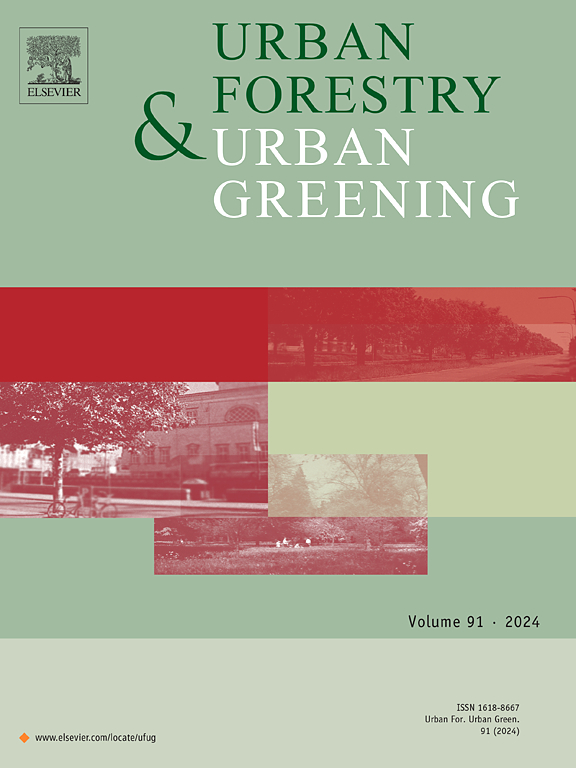Exploring recreational walking and its correlated built environment factors in river corridor space through a trajectory sematic-based approach
IF 6
2区 环境科学与生态学
Q1 ENVIRONMENTAL STUDIES
引用次数: 0
Abstract
Investigating recreational walking in river corridor areas—an important green and blue space—is essential for developing a walking-friendly city and achieving Sustainable Development Goals (SDGs) 3. However, existing studies have yet to thoroughly explore the specific behaviors characteristics of walking in these spaces, particularly through the lens of high-resolution geo-located data such as GPS tracks. This study addresses this gap by mining moving, staying, and photo-taking behaviors from trajectory data, grounded in a semantic conceptual model developed by GIS scholars. Using the river corridor in downtown Guangzhou as a case study, we analyze the spatial distribution and potential environmental factors influencing recreational walking activities. Our findings reveal that: (1) The patterns of moving, staying, and taking photos during recreational walking in river corridors exhibit diverse spatial distributions; moving is homogeneously distributed, while the latter two show typical spatial heterogeneity. (2) The characteristics of the three types of recreational walking are linked to the built environment, with varying strengths of correlation; staying behavior is most influenced by built environment factors. Based on these results, we propose planning strategies to enhance the quality of waterfront spaces, emphasizing the creation of flower borders and ensuring transportation accessibility to meet the outdoor activity needs of residents.
基于轨迹语义的河道廊道空间休闲步行及其相关建筑环境因子研究
在河流廊道地区——一个重要的绿色和蓝色空间——调查休闲步行对于发展步行友好型城市和实现可持续发展目标(SDGs)至关重要。然而,现有的研究尚未彻底探索这些空间中行走的具体行为特征,特别是通过GPS轨迹等高分辨率地理定位数据的镜头。本研究以GIS学者开发的语义概念模型为基础,通过从轨迹数据中挖掘移动、停留和拍照行为来解决这一差距。以广州市中心城区河道廊道为例,分析了游憩步行活动的空间分布及其潜在环境影响因素。研究结果表明:①游憩步道的移动、停留和拍照模式呈现出不同的空间分布特征;移动是均匀分布的,而后两者表现出典型的空间异质性。(2)三种休闲步行类型的特征与建成环境相关联,且相关强度不同;居住行为受建筑环境因素的影响最大。基于这些结果,我们提出了提高滨水空间质量的规划策略,强调花边界的创造,并确保交通可达性,以满足居民的户外活动需求。
本文章由计算机程序翻译,如有差异,请以英文原文为准。
求助全文
约1分钟内获得全文
求助全文
来源期刊

Urban Forestry & Urban Greening
FORESTRY-
CiteScore
11.70
自引率
12.50%
发文量
289
审稿时长
70 days
期刊介绍:
Urban Forestry and Urban Greening is a refereed, international journal aimed at presenting high-quality research with urban and peri-urban woody and non-woody vegetation and its use, planning, design, establishment and management as its main topics. Urban Forestry and Urban Greening concentrates on all tree-dominated (as joint together in the urban forest) as well as other green resources in and around urban areas, such as woodlands, public and private urban parks and gardens, urban nature areas, street tree and square plantations, botanical gardens and cemeteries.
The journal welcomes basic and applied research papers, as well as review papers and short communications. Contributions should focus on one or more of the following aspects:
-Form and functions of urban forests and other vegetation, including aspects of urban ecology.
-Policy-making, planning and design related to urban forests and other vegetation.
-Selection and establishment of tree resources and other vegetation for urban environments.
-Management of urban forests and other vegetation.
Original contributions of a high academic standard are invited from a wide range of disciplines and fields, including forestry, biology, horticulture, arboriculture, landscape ecology, pathology, soil science, hydrology, landscape architecture, landscape planning, urban planning and design, economics, sociology, environmental psychology, public health, and education.
 求助内容:
求助内容: 应助结果提醒方式:
应助结果提醒方式:


